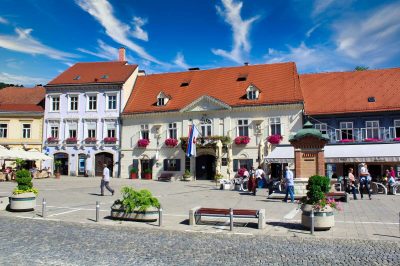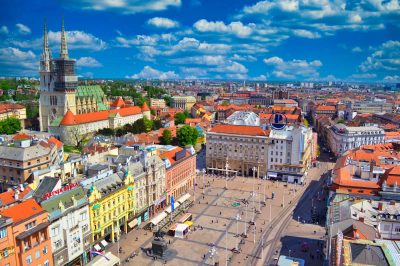After we have already introduced you to Zagreb and Belgrade, two beautiful cities in Southeastern Europe, we are taking you to Slovenia today, more precisely to its capital, where we want to introduce you to the most beautiful Ljubljana sights. For centuries, the town was part of the Austro-Hungarian sphere of influence and to a certain extent lay at the point of contact between German and Slavic culture. This was particularly evident in the city’s architectural history, but also in the everyday life of the city inhabited by Germans and Slovenes. The result is an exciting mix that still characterizes the Slovenian capital today.
The history of Ljubljana
The area around Ljubljana was already inhabited in prehistoric times, with people settling mainly in the Ljubljana Marshes south of the present-day town center. In the late Bronze Age and the beginning of the Iron Age, there were migratory movements and the arrival of tribes, including Illyrians and Venetians. Around this time, a settlement was also established at the foot of the castle hill towering high above the town, which was easy to defend due to the natural conditions.
The old Emona
According to legend, it was later the legendary Argonaut Jason who founded a city that would henceforth bear the name Emona. Since Jason supposedly killed a dragon here, the dragon is still part of the city’s coat of arms and can be seen as a mascot everywhere in Ljubljana. Towards the end of the first century BC, the Romans arrived on the scene and left their mark on the following centuries. Emona was officially renamed Colonia Iulia Emona. The settlement was extremely advanced, for example it had a sewage system and was integrated into the Roman water and road network. In its heyday, Emona had up to 5,000 inhabitants (before a plague outbreak claimed many victims in the 2nd century) and existed until the 5th century.
Downfall and new beginning
The period of migration was to prove fatal. In particular, Emona was not to recover from a Hun attack in the 5th century. The inhabitants moved on and the town fell into ruin. Slavs subsequently settled in the region, in larger numbers from the 7th century onwards. Ljubljana, as the town was called in German and is still called in Austria today, was first mentioned in a document in the middle of the 12th century in a deed of donation. This document also mentions a certain Rudolf, who owned a castle on today’s Burgberg. The town subsequently grew considerably.
The Habsburgs enter the scene
In 1270 Ljubljana was conquered by the Bohemian king Přemysl Ottokar II, who was also the duke of Carinthia and Carniola and of Austria. Later, Ljubljana became the property of the Habsburgs via detours. Apart from brief interruptions, they were to set the tone in the city from then on until the end of the First World War. For Ljubljana, belonging to the Habsburg dominion was a stroke of luck, as it opened up new trade opportunities and new markets. As a result of the boom, many Jewish and Italian merchants moved to the city, which was already home to many Germans.
In 1511, Ljubljana was hit by a devastating earthquake. At this time, Ljubljana was already a considerable small town with around 6000 inhabitants. The Reformation was to prove particularly drastic, and soon two thirds of the town’s population no longer followed Catholic doctrine. The Thirty Years’ War and an outbreak of plague caused a deep crisis from which Ljubljana was unable to recover for a long time.
Years of flowering
In 1754, an official census was carried out for the first time, which showed that Ljubljana had 9400 inhabitants. In terms of culture, Ljubljana flourished in the 18th century. It was not only thanks to the introduction of compulsory education in the empire in 1774 that the level of education of the citizens rose, theaters were also established and music played an increasingly important role in the public life of the city. From 1807, France began to conquer the territories on the Adriatic and shape them according to its own ideas. The city’s return to the Habsburg fold was relatively smooth. As a result, numerous new buildings were erected in the city.
In 1821, the attention of the whole of Europe turned to the tranquil town of Ljubljana, as it hosted the Ljubljana Congress, which presented the town with logistical challenges and brought several crowned heads to the town, including Emperor Francis I, Tsar Alexander I and King Ferdinand I of the Two Sicilies. By far the most drastic event in those years was the great earthquake of 1895, which destroyed around 10 percent of the historic buildings. It was none other than the famous architect Max Fabiani who subsequently had numerous buildings erected, including some in the Art Nouveau style.
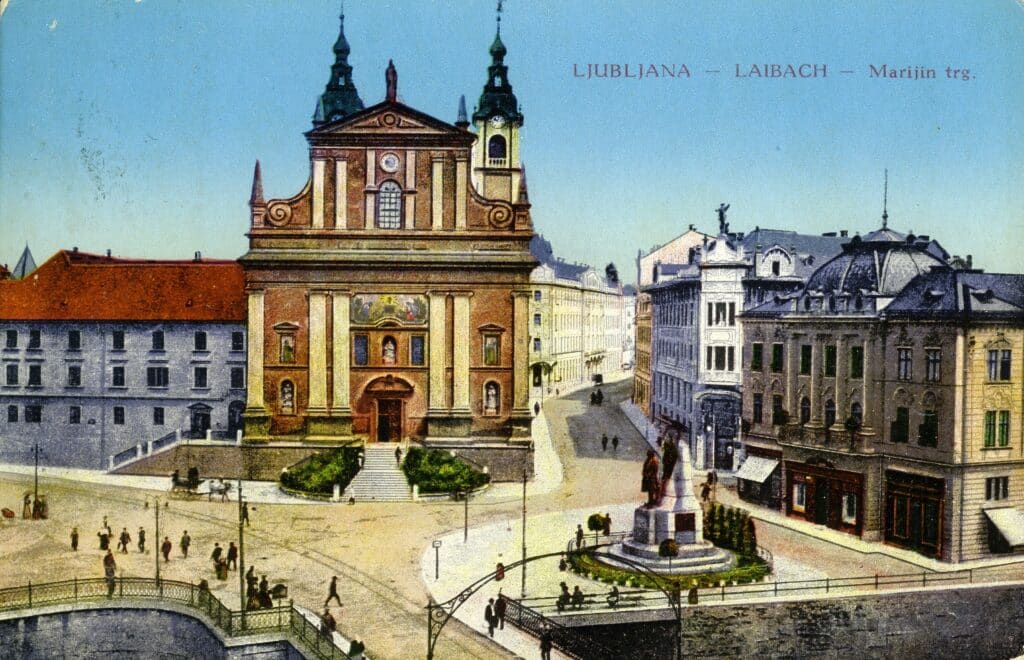
However, the years before the First World War were also characterized by the growing contrast between the German-Austrian and Slovenian populations, who each maintained a number of their own cultural and political institutions, many of which still exist today and are among the most beautiful sights in Ljubljana.
Ljubljana in the 20th century
The loss of the First World War and the disintegration of Austria-Hungary also had a massive impact on Ljubljana. The city was now called Ljubljana and became part of the newly founded Kingdom of Serbs, Croats and Slovenes in October 1918. As a result, the city underwent significant renovations by the Fabiani confidant Jože Plečnik, who had worked mainly in Vienna before the First World War and changed Ljubljana forever. During the Second World War, the city was occupied by Italians and Germans. Ljubljana then became the capital of the Socialist Republic of Slovenia within the Socialist Federal Republic of Yugoslavia. Josip Broz (“Tito”) died in the University Hospital of Ljubljana in 1980. Slovenia’s independence from Yugoslavia was declared here in 1991.
Ljubljana today
Slovenia joined the EU and NATO in 2004. Today, Ljubljana presents itself as a modern city in which the historical heritage is preserved. The concept of sustainability also plays a major role, which earned Ljubljana the title of “European Green Capital” in 2016. Ljubljana’s many sights attract tourists from near and far, and the city is also very popular with visitors from Germany and Austria.
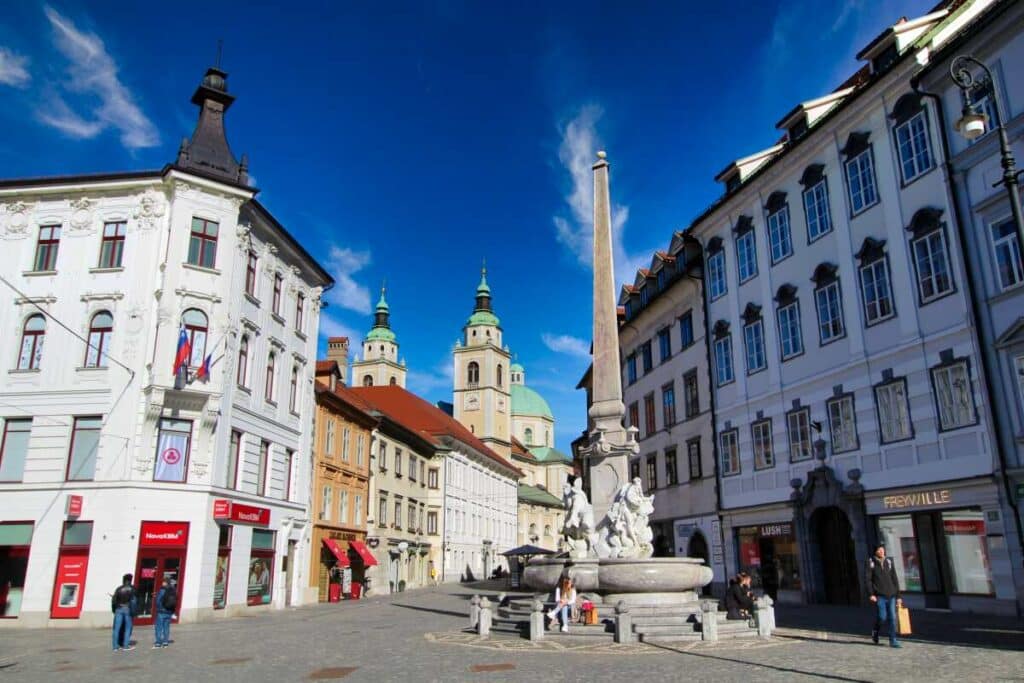
Town Hall Square (Mestni trg)
One of the city’s most beautiful squares is located on the right bank of the Ljubljanica river, which flows through the city. The name square is perhaps a little misleading, as it is more of an elongated street lined with magnificent historic houses like a string of pearls. One of the eye-catchers on the square is the historic town hall. It was built in the 15th century, but was later baroqueized. In the inner courtyard there is a fountain depicting Narcissus, designed by Francesco Robba, who was also responsible for the Fountain of the Three Rivers of Carniola (Vodnjak treh kranjskih rek), modeled on the Fountain of the Four Rivers in Piazza Navona in front of the town hall.
A famous resident
Directly opposite the town hall is a building that may seem somewhat inconspicuous in view of the many magnificent buildings on Rathausplatz, but it had a famous resident. Between 1881 and 1882, the Krisper House (not to be confused with another building of the same name) was home to its most famous resident, the composer Gustav Mahler, who stayed here with the family of his childhood friend Anton Krisper. Mahler had his first ever permanent position here, but moved on shortly afterwards.
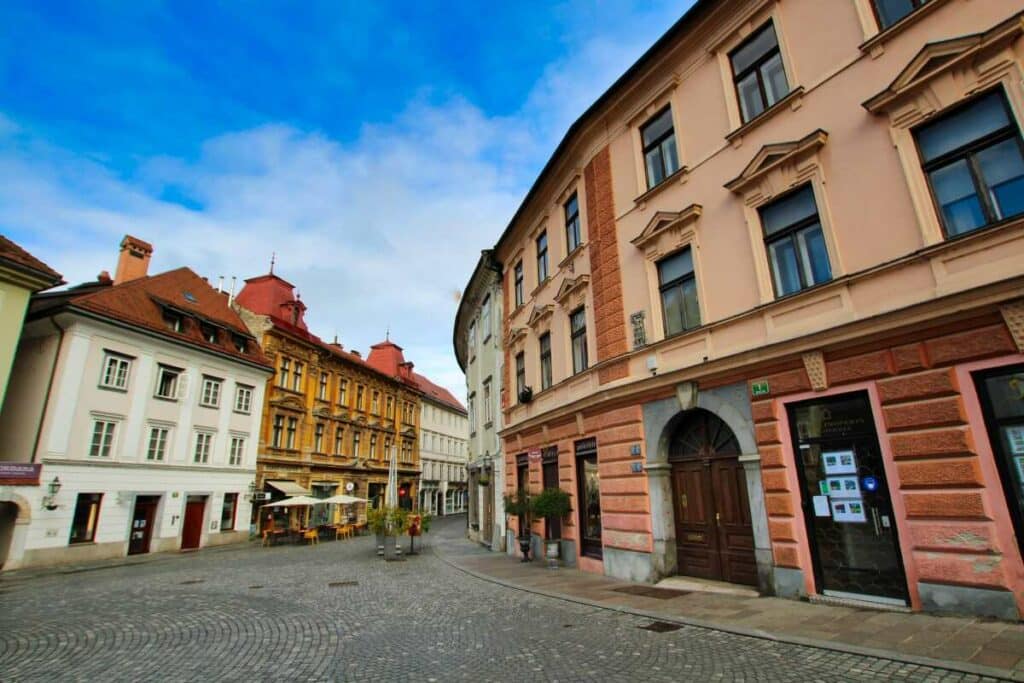
Old Market (Stari trg)
There is hardly any other place where you can immerse yourself in the past as much as at the Alter Markt, which has retained its old character and where a stroll is like a short journey through time. Just like the Rathausplatz, to which it adjoins to the south, it is also elongated. One of the best-known and most beautiful buildings on the Old Market Square is the Schweiger House (Schweigerjeva hiša). The Sitticherhof (Stiški dvorec) , which forms the southern end of the square, is also beautiful. A statue of Hercules stands in front of the Sitticherhof. The inhabitants of the town had to do without this for a long time, as its Baroque predecessor was torn down in the 18th century before this modern interpretation was installed here in the 1990s and the original was moved to the town hall.
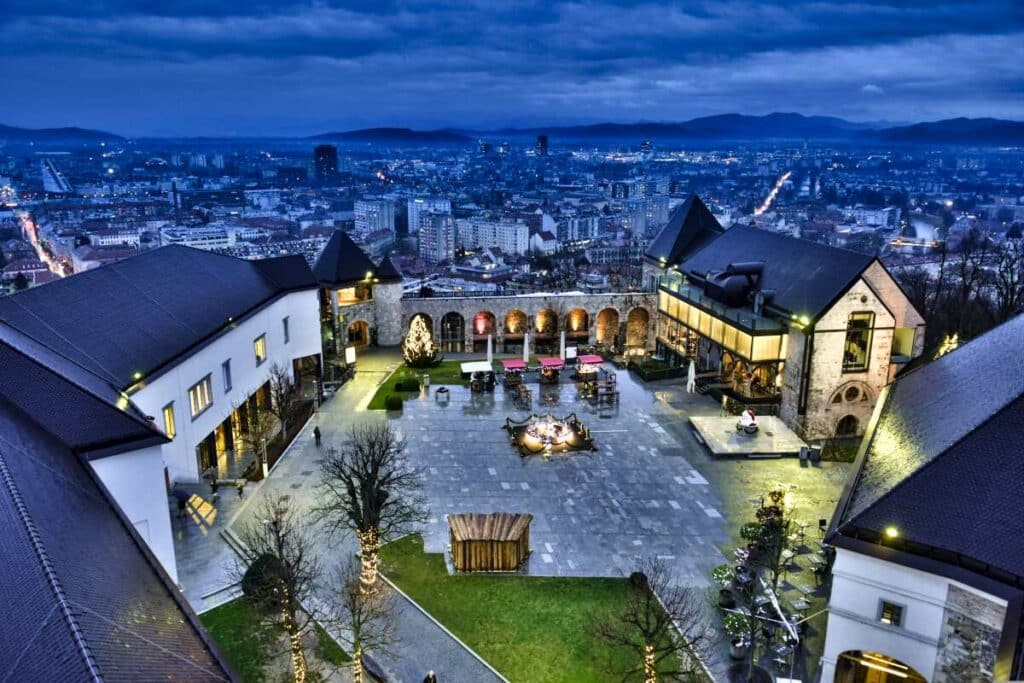
Ljubljana Castle (Ljubljanski Grad)
A network of alleyways and footpaths (or the funicular!) takes you from the eastern part of the old town up to the mighty castle hill. From here you have a fantastic view of the city! Little is known about the exact origins of the complex, but it owes its current appearance to Renaissance-style renovations. From the middle of the 18th century, the castle was used as a prison. During the First World War, the castle was then used as a transit station for Italian prisoners of war. At times, up to 4,500 prisoners were interned here at the same time, although they were able to manage themselves and enjoyed some freedom. Several exhibitions are housed in the castle, where you can learn about Slovenian history, among other things.
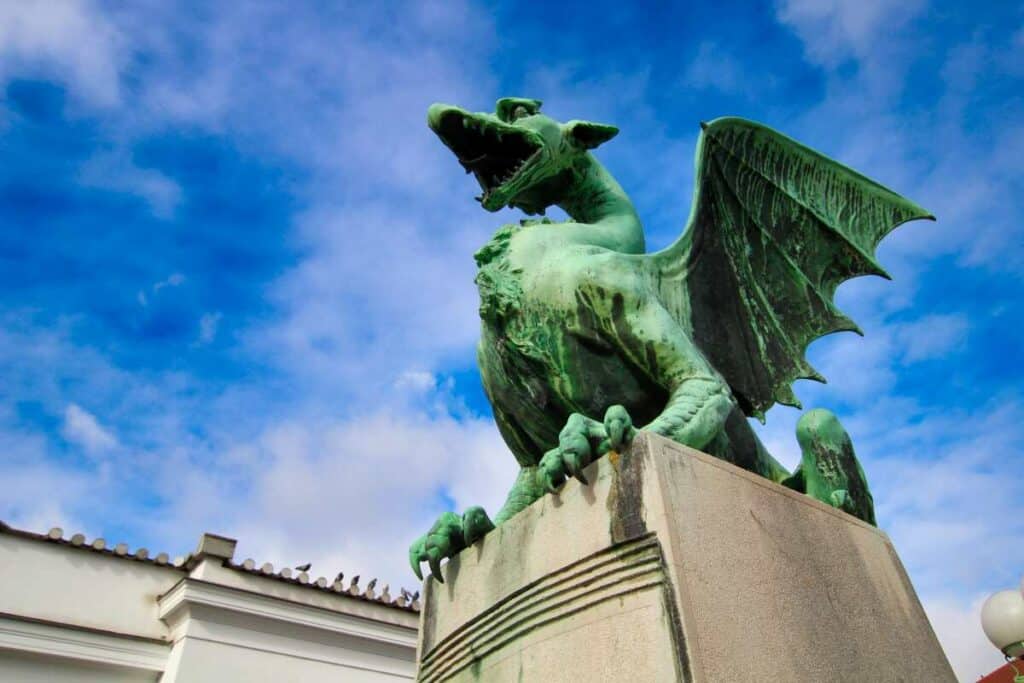
Ljubljanica bank
Nowhere is Ljubljana more beautiful than by the water. The Ljubljanica divides the old town into a western and an eastern section and is characterized by beautiful buildings on both banks. Most worth seeing, however, are the many bridges that cross the river. The Dragon Bridge (Zmajski Most) stands for Ljubljana like no other building and is one of the city’s most popular photo motifs due to its Art Nouveau character and the sinister-looking dragons.
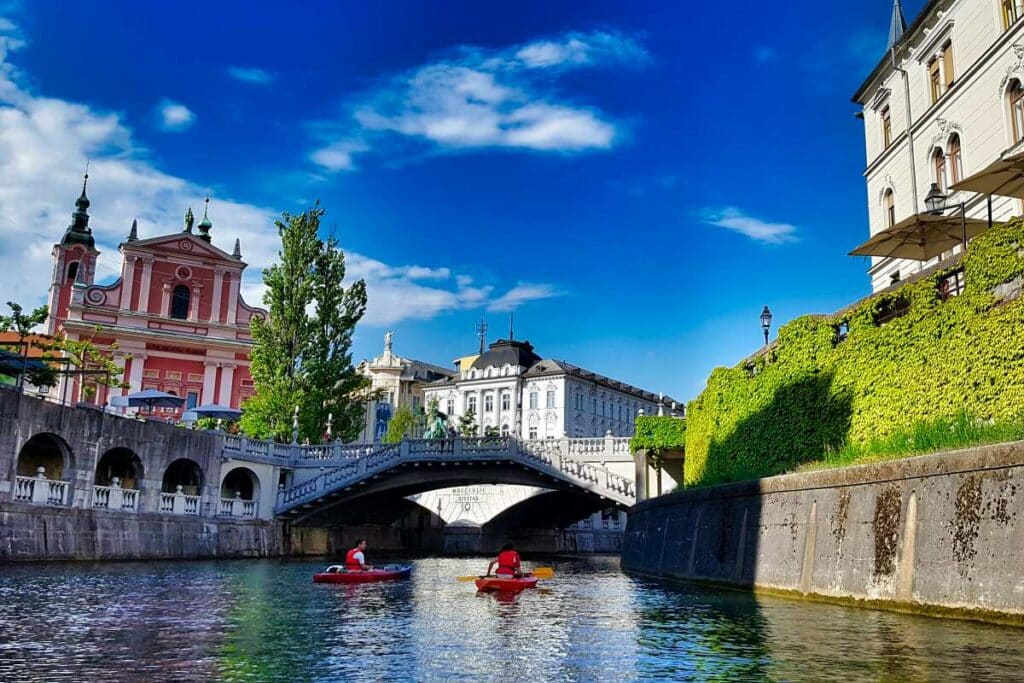
The Triple Bridge (Tromostovje), which lives up to its name, is also unusual, as it actually consists of three bridges that connect the Town Hall Square with Prešeren Square. Jože Plečnik, who shaped the city like no other, was responsible for this building (as well as many others).
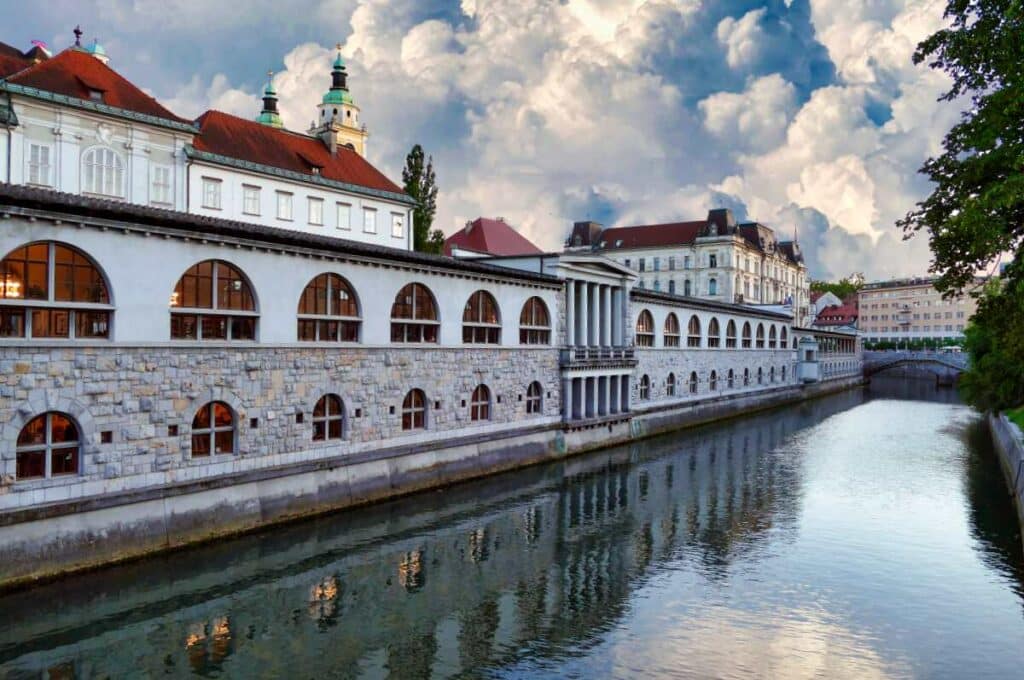
He was also responsible for the design of the Cankar Embankment (Cankarjevo nabrežje) and the Adamič Lunder Embankment (Adamič-Lundrovo nabrežje), both of which are inviting places to stroll and, in the latter case, also have a beautiful market hall.
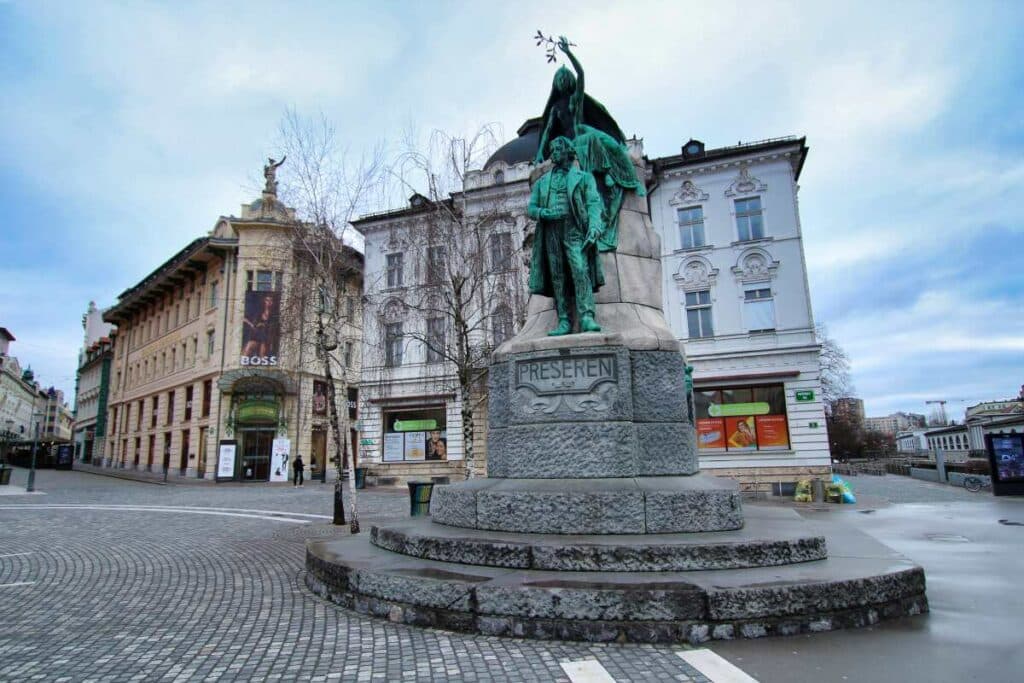
Prešeren Square (Prešernov trg)
With so many sights on the square, it’s hard to know where to look first, there’s so much to see here. The Franciscan Church (Frančiškanska cerkev) is also known as the Church of the Annunciation and gave its name to St. Mary’s Square before it was renamed Prešeren Square.
This commemorates France Prešeren, for whom a beautiful monument was erected here. He is considered the most important representative of Slovenian Romanticism and wrote his works in both Slovenian and German. Behind the monument is the Urbanc House (Urbančeva hiša), a magnificent Art Nouveau department store, and the Mayer House (Mayerjeva palača), a splendid pharmacy.
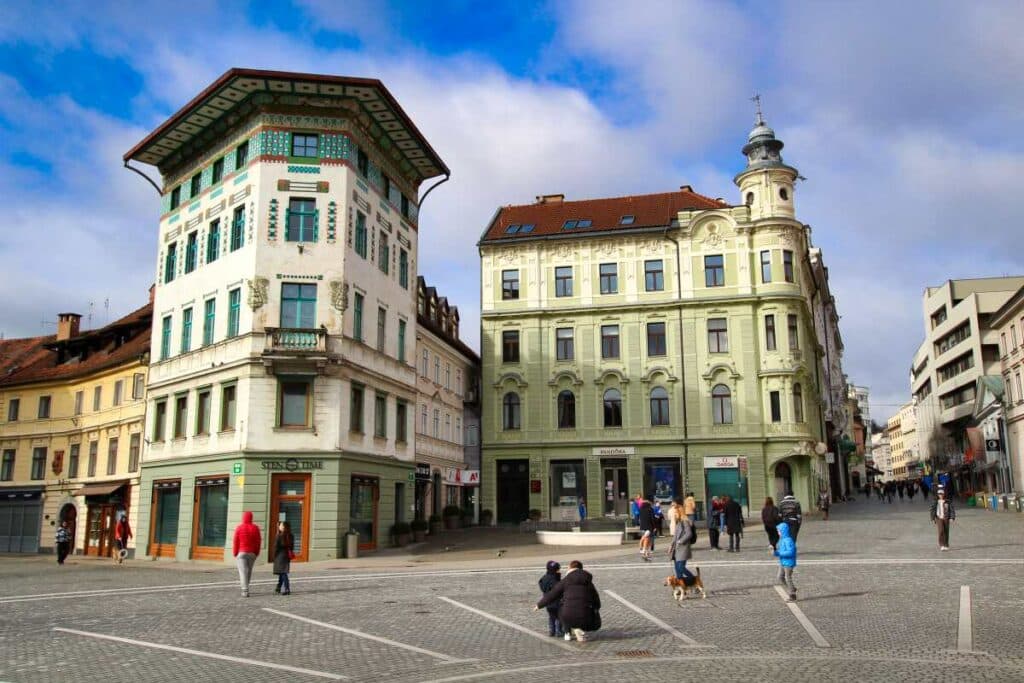
But perhaps the most visually striking building is on the other side. The Hauptmann House (Hauptmannova hiša) immediately catches the eye due to its unusual shape, which resembles a flattened arrowhead. In addition to its shape, it stands out in particular because of the many colorful ceramic tiles that the architect Ciril Metod Koch had installed here, giving the building a playful lightness.
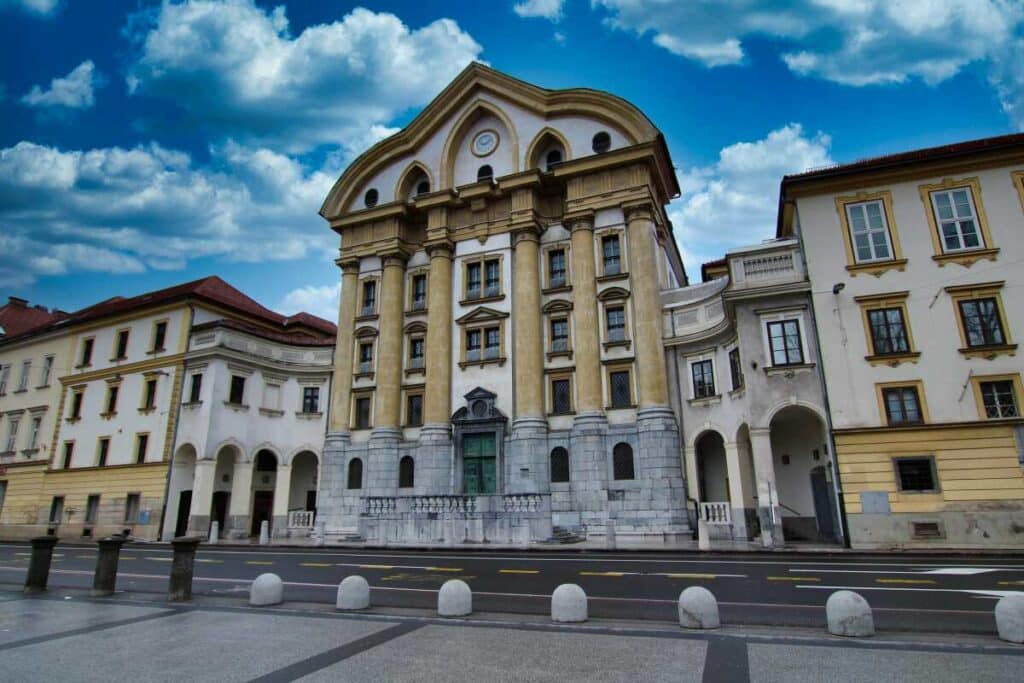
Congress Square (Kongresni trg)
Congress Square adjoins Prešernov trg to the south. The north side of Congress Square is dominated by the mighty casino building , which once served as an entertainment venue for the upper class. The Baroque Ursuline Church (Uršulinska cerkev) on the western side of Congress Square has without doubt one of the most spectacular facades in the city. The columns and many windows that characterize the façade are probably reminiscent of Venetian aristocratic palaces. However, the undulating gable that crowns the façade is particularly characteristic. Inside, the church is almost snow-white, with the black African marble work providing an interesting visual counterpoint. Jože Plečnik had the stairs redesigned in the 1930s.
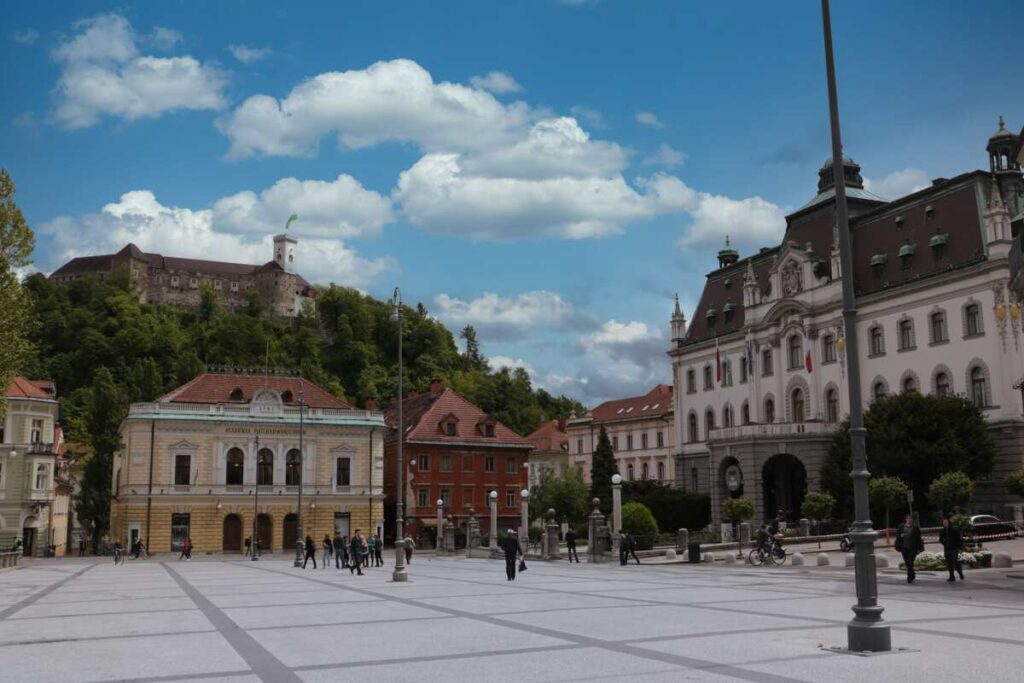
Right opposite the Ursuline Church, at the eastern end of the square, stands one of the city’s most interesting buildings, the City Philharmonic Hall (Filharmonija). Adolf Wagner created a neo-Renaissance masterpiece here. Wagner always had the baroque Ursuline Church directly opposite in mind and used rounded shapes here too, so that the two buildings form a harmonious whole. In the main hall of the Philharmonie, a statue commemorates its most famous conductor, Gustav Mahler, who conducted the orchestra between 1881 and 1882.
The Kranjski deželni dvorec (Carniolan Provincial House) stands on the south side of the square. Like so many buildings, it was built after the devastating earthquake of 1895 and once housed the Carniolan parliament, in a sense the regional parliament. Jan Vladimír Hráský created a magnificent building in the Neo-Renaissance style with Gothic elements and a spectacular façade with a balcony. The regional parliament and the regional governor appointed by the emperor met in the building. The 14 coats of arms of the towns of Carniola can be seen on the façade. After the First World War, the newly created University of Ljubljana moved into the building, where it still has its headquarters today.
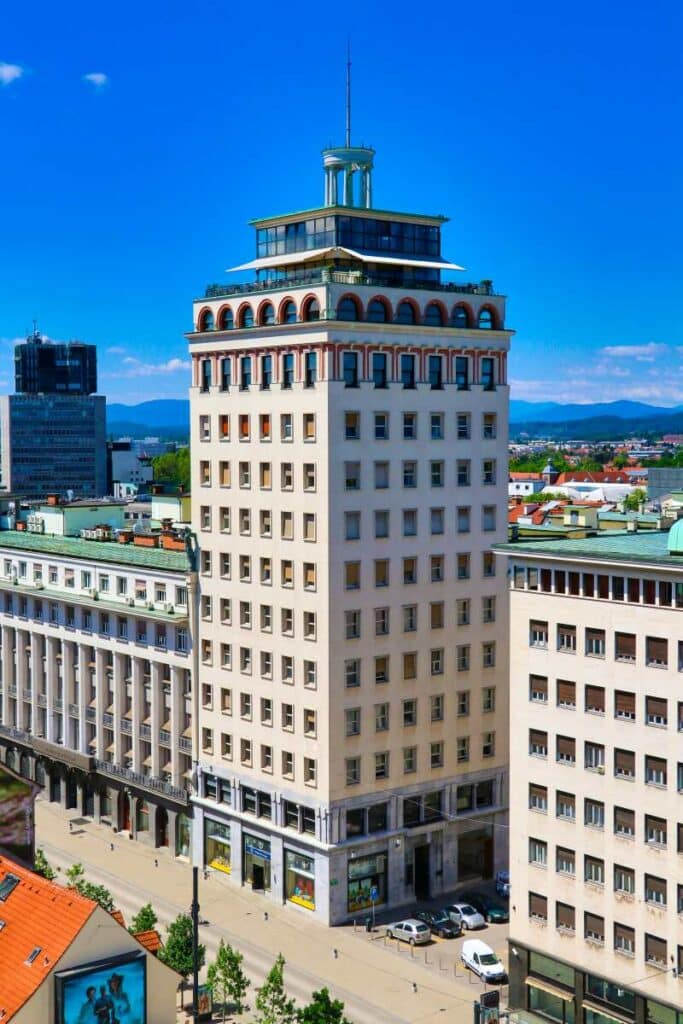
Skyscraper (Nebotičnik)
Admittedly, the Nebotičnik does not reach New York standards, but when it was inaugurated in 1933, it was the tallest building in the Balkans at a height of 70 meters. The idea for the construction of the skyscraper came from the influential Slovenian architect Vladimir Šubic, who had a significant impact on the modernist movement in Slovenia. His architectural design is a prime example of early European modernism and is characterized by clear lines, functional simplicity and geometric shapes. The façade of the building is criss-crossed by horizontal and vertical lines and conveys a timeless, elegant impression.
National and University Library (Narodna in univerzitetna knjižnica)
The history of the NUK dates back to the 18th century, when the Jesuit library was founded in Ljubljana. In 1774, the library was transformed into a public institution, laying the foundation for what would later become the NUK. The main library building, built between 1936 and 1941, is another masterpiece by Jože Plečnik.
The architecture of the building combines elements of Baroque and Art Nouveau and is a symbol of the fusion of tradition and modernity. The building is also a tribute to Slovenian culture, as it integrates elements of folk art and folklore into its design.
Tivoli Park (Park Tivoli)
Tivoli Park to the west of the city center is still the largest park in Ljubljana and one of the city’s most beautiful oases of peace. It is thanks to Field Marshal Radetzky of Radetz that it was opened to the public. Avenues, fountains and spacious steps – there is nothing lacking here.
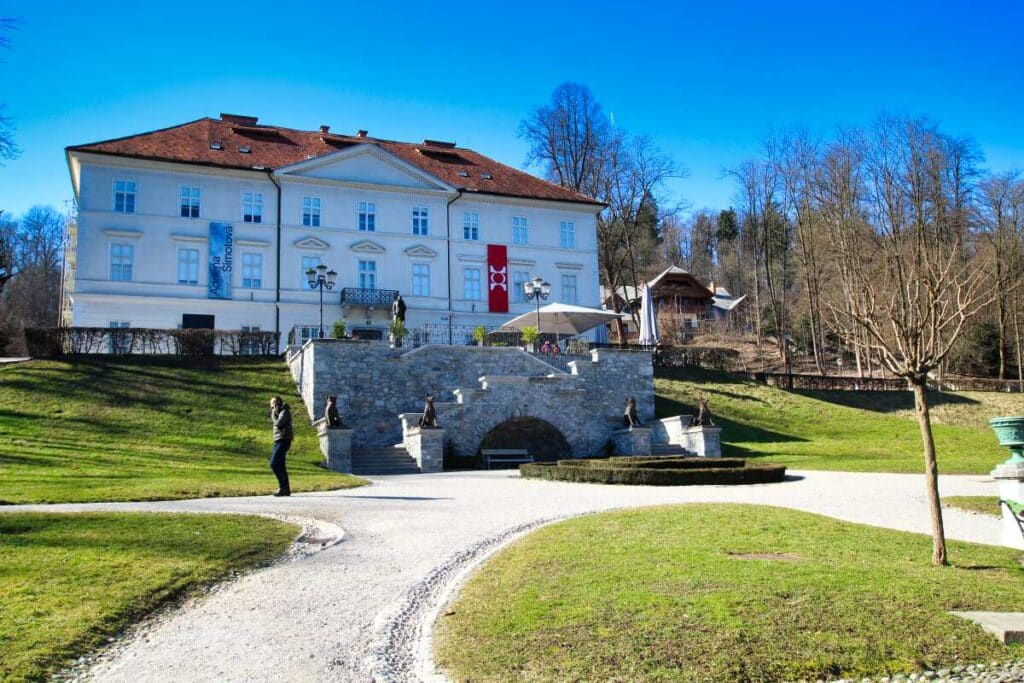
One of the most beautiful places in Tivoli Park is located in the eastern part of the area, and due to its elevated position and the central visual axis, it is easily recognizable even at the entrance of the park. Radetzky von Radetz had Unterthurn Castle (Tivolski Grad) remodeled here into his retirement residence. Today exhibitions are held here. On the eastern edge of Tivoli Park, north of Tivoli Castle, stands another magnificent building from the time of old Ljubljana, the Sequin Palace (Cekinov Grad) , originally named Leopold’s Rest. Today here is the Museum of Contemporary History is housed.
Book tips Ljubljana sights
You haven’t had enough of Ljubljana’s sights yet and are planning a trip to Ljubljana? Then these two book tips might be just the thing for you!
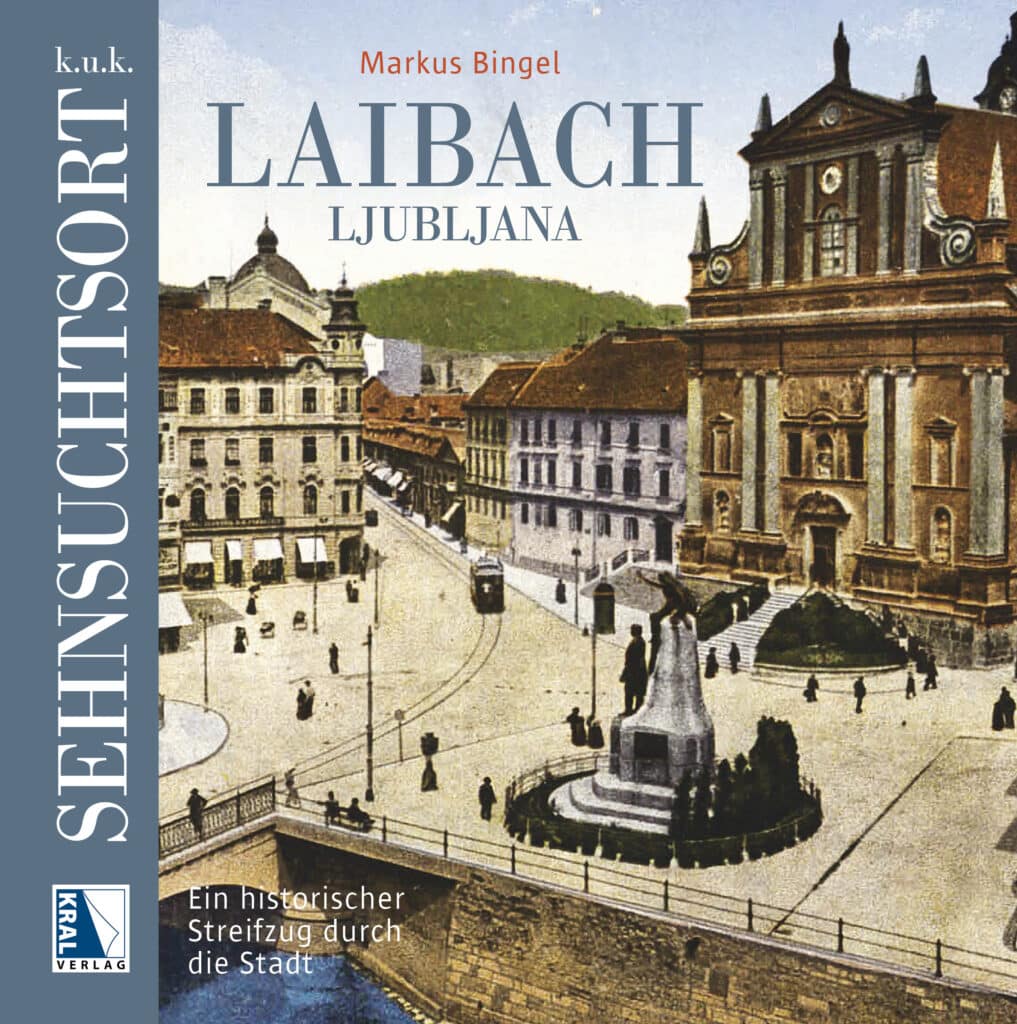
This book has just been published by Kral Verlag. It sheds light on the eventful history of old Ljubljana. The centuries-long affiliation of the city to the Habsburg Empire has left its mark on the cityscape to this day, with relics of the time before the First World War to be found on every corner. In this book, I go in search of traces and tell the story of the city.
Afterwards, I will take you on a stroll through Ljubljana and show you which places are still characterized by Ljubljana and the imperial and royal era. times. Supplemented by numerous historical photos, maps and postcards, the old Ljubljana is brought to life. You can either order the book directly from the publisher here (and thus support them) or Hugendubel (here with preview) as well as via Amazon*.
- Schetar, Daniela (Author)
This compact travel guide from the Reise Know-How publishing house introduces you to the most beautiful Ljubljana sights, contains numerous practical tips, restaurant recommendations and even some excursions to the surrounding area, such as to Škofja Loka or Kamnik.
How did you like our trip to Slovenia? Have you ever been to Ljubljana? If so, what are the best sights in Ljubljana for you? Let us know and write us a comment!


